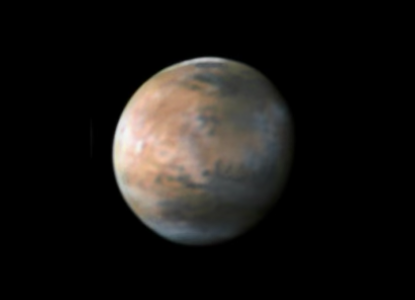Crazy Facts About The #YearInSpace
Crazy Facts About the #YearInSpace
Astronaut Scott Kelly and Russian cosmonaut Mikhail Kornienko returned from their One-Year Mission on March 1. When you spend a year doing anything, you’re bound to accumulate some crazy stats. Here are a few:

During their year in space, Kelly and Kornienko traveled over 143 million miles, conducting research to prepare us for our journey to Mars, which will be about 140,000,000 miles from Earth.

The International Space Station travels at a speed of 5 miles per second and orbits the Earth every 90 minutes.

These visiting vehicles brought food, supplies, experiments and more crew members to the space station.

Since the space station is orbiting the Earth at 17,500 miles per hour, the crew onboard sees 16 sunrises and sunsets each day.

Water is a precious and limited resource in space, so crew members recycle it whenever possible. That includes recycling their own urine.
Make sure to follow us on Tumblr for your regular dose of space: http://nasa.tumblr.com
More Posts from Nasa and Others
Solar System: Things to Know This Week
In addition to the Mercury transit of the sun today, there are a few other things you should know about our solar system this week:
1. Mars, Ready for its Close-Up

Mars will soon be closer to Earth than it has been for 11 years, presenting a great opportunity for backyard sky watchers.
2. Fire and Ice

Our spacecraft have an even closer view of Mars, and that fact regularly leads to some intriguing discoveries. The latest: volcanoes may have erupted beneath an ice sheet there billions of years ago. The above image is a mineral map of part of the Martian surface.
3. Icy Hydra

Meanwhile, our New Horizons spacecraft has sent home the first compositional data about Pluto's four small moons. The new data show the surface of Hydra is dominated by nearly pristine water ice--confirming hints that scientists picked up in images showing Hydra's highly reflective surface.
4. Ceres, Ever Sharper

The mission director for our Dawn mission writes, "Ceres, which only last year was hardly more than a fuzzy blob against the stars, is now a richly detailed world, and our portrait grows more elaborate every day."
5. Join us at Jupiter

Our Juno mission arrives at the giant planet on Jul. 4. Meanwhile, all amateur astronomers are invited to take part in a worldwide effort to identify potential observations for the spacecraft to make once it's in orbit. Find out how to join HERE.
Want to learn more? Read our full list of the 10 things to know this week about the solar system HERE.
Make sure to follow us on Tumblr for your regular dose of space: http://nasa.tumblr.com
Benefits To Humanity
How does research in space help life on Earth? That’s a great question! It seems crazy that a laboratory orbiting about 200 miles over us can have a benefits on science on the ground. Here are a few ways that research aboard the International Space Station benefits humanity:

Improve Human Health
The space station has supported research that supports areas such as aging, trauma, disease and the environment. Advances in human health have been gained from the unique microgravity environment.
For example, crew aboard the station experience issues such as bone loss while in space. Learning about the causes and understanding the treatments can help the elderly or people prone to Osteoporosis here on Earth.

Are you Asthmatic? Crew aboard the space station use a tool that could be used for Asthma patients. The lightweight, easy-to-use device is used to monitor levels of asthma control and the efficiency of medication. This leads to more accurate dosing, reduced attacks and improved quality of life.
Drinkable water on the space station isn’t something just sitting in water bottles waiting to be consumed. Since storage and weight are limited in transporting things to space, crew members must recycle old, dirty water and reuse it day after day. The technology they use for this on the space station, can also be used in at-risk areas on Earth that don’t have access to clean water.

Earth Observations
The International Space Station has a unique vantage point for observing Earth’s ecosystems. A wide variety of payloads can be attached to the station’s exterior to collect data on things like: global climate, environmental change and natural hazards.
Farming from Space
Farmers can leverage images from the International Space Station to grow crops. The camera captures frequent images of Earth in visible and infrared light, that helps farmers monitor crop growth for disease or fertility differences.
From NASA to Napa. Some of the research on the space station has even provided benefits to the wine industry on Earth! Solutions for growing crops in space translates really well to solutions for mold prevention in wine cellars and other confined spaces on Earth.

For many other ways that research on the International Space Station benefits life on Earth, go HERE.
Make sure to follow us on Tumblr for your regular dose of space:http://nasa.tumblr.com
Four Things ECOSTRESS Can See From Space
Our new instrument in space, the Ecosystem Spaceborne Thermal Radiometer Experiment on Space Station (ECOSTRESS), is designed to study how plants respond to heat and water stress by measuring the temperature of Earth's vegetation, but that’s not all it will do. Adding ECOSTRESS to the Space Station will also add to our understanding of volcanoes, fires, urban heat and coastal and inland waters.

1. Fires
ECOSTRESS's radiometer can detect all kinds of fires, but it may be most useful in recording small fires – new wildfires that are just beginning to grow. These have proven hard to study from satellite observations. ECOSTRESS has a pixel size of only 130 by 230 feet (40 by 70 meters), offering a much sharper view. "We'll be able to see a bonfire on a beach," ECOSTRESS scientist Simon Hook says.

Credit: USGS
2. Volcanoes
ECOSTRESS's thermal infrared imager will be able to spot new fissures and hotspots that can signal impending volcanic eruptions.

The Chiliques volcano in Chile was thought to be dormant until thermal images revealed new activity. Credit: NASA/METI/AIST/Japan Space Systems and U.S./Japan ASTER Science Team
3. Urban Heat
The heat generated by a large city can compound the health hazards of heat waves, particularly for the oldest and youngest city dwellers. Which neighborhoods suffer from heat the most? With the very detailed images from ECOSTRESS, we'll be able to see which mitigation efforts are keeping neighborhoods cool.

Urban areas can be up to 8 degrees warmer than surrounding suburban or natural landscapes, as seen here in a true-color image of the Atlanta area, top, and temperature data, bottom. Credit: NASA
4. Coastal and Inland Waters
Along coastlines and in large lakes, wind can push surface water aside allowing water from the depths to rise to the surface, bringing nutrients. These upwellings of cold water are important sources of nutrition for the coastal and lake plants and animals. ECOSTRESS can detect these smaller upwellings, providing valuable information for researchers.

Upwelling can be seen in satellite data. Here temperature data (top) and chlorophyll concentrations (bottom) are shown around the Isthmus of Tehuantepec in Mexico. Credit: MODIS Ocean Color Team/Norman Kuring
Read more about the ECOSTRESS mission at https://ecostress.jpl.nasa.gov/. Make sure to follow us on Tumblr for your regular dose of space: http://nasa.tumblr.com
What are you most excited for in 2020?
Hilary Swank cartwheeling through Mission Control >>> the feel good content we’re looking for.
To get some insight on playing an astronaut going to Mars, Hilary took a trip to Johnson Space Center and spoke with astronaut Jessica Meir who lived aboard the International Space Station for over 200 days!
Watch the duo talk about living in space, life on Earth after a mission and more! Check out her whole visit HERE: https://youtu.be/8NRJvUlpuKI
Make sure to follow us on Tumblr for your regular dose of space: http://nasa.tumblr.com

Happy “Back to the Future Day”!
Find out more about @nasa‘s real journey to Mars:
https://www.nasa.gov/journeytomars
How to Connect with NASA
We're the nation’s space agency, but that doesn’t mean you have to travel to the depths of the universe to stay connected with the awesome stuff we’re doing. There are actually some really easy ways to stay updated on all things space. Check them out:
Apps

We have lots of apps for smartphones and tablets that will make it easier than ever to stay connected to space. Here are a few to pique your interest:
NASA App: Showcases a huge collection of the latest content, including images, videos, mission information, stories, space station sighting opportunities and more! Download: Apple/Android
NASA Spinoff App: This application profiles the best examples of technology that have been transferred from NASA research and missions into commercial products. From life-saving satellite systems to hospital robots, our technologies benefit society. Download: Apple
NASA 3DV App: The 3DV mobile app allows you to examine several of our Deep Space Exploration projects that will take our space program to asteroids, Mars and beyond! Download: Apple/Android
Spacecraft 3D: This augmented reality (AR) application lets you learn about and interact with a variety of spacecraft that are used to explore our solar system, study Earth and observe the universe. Download: Apple/Android
Competitions and Challenges

NASA Solve is an invitation to members of the public to contribute their time and expertise to solving problems and potentially winning prizes as a result of their work. This is a great way for individual members of the public to be a part of the nation’s space program. For a complete list of current challenges and competitions, visit THIS page.
Citizen Science
You don’t have to be a NASA employee to engage in the fun of interpreting scientific data and imagery from our many spacecraft and missions. As part of our Open Government plan, our goal is to promote transparency, participation and collaboration. By expanding the research base and using open innovation, we are all able to benefit from the accumulated findings. You can find data from our missions, research and activities HERE.
Email and Social Media
We have a wide-range of social media accounts here at NASA. Everything from Earth Science to the Mars Curiosity Rover, you can stay updated on many of our missions on many popular social media sites. For a full list of our accounts, visit THIS page.
If you’d like to get space news delivered straight to your inbox, you can sign up for updates and manage preferences HERE.
NASA Socials

What is a NASA Social? We’re glad you asked! These programs provide opportunities for our social media followers to learn and share information about our missions, people and programs. NASA Social includes both special in-person events and social media credentials for individuals who share the news in a significant way. Social events provide the participants with the opportunity to go behind-the-scenes at our facilities and events and speak with scientists engineers, astronauts and managers. Visit THIS page for a list of upcoming NASA Social opportunities.
Make sure to follow us on Tumblr for your regular dose of space: http://nasa.tumblr.com
It’s Pi Day!
Pi Day, the informal holiday beloved by math enthusiasts — and even by the math averse — is here! March 14 marks the yearly celebration of the mathematical constant π (pi).

What is Pi?
Pi (3.1415….) is the ratio of circumference to diameter in a circle. Any time you want to find out the distance around a circle when you have the distance across it, you will need this formula.
Despite its frequent appearance in math and science, you can’t write pi as a simple fraction or calculate it by dividing two integers. For this reason, pi is said to be “irrational.” Pi’s digits extend infinitely and without any pattern, adding to its intrigue and mystery.
How Do We Use Pi at NASA?

Measurements: Pi can be used to make measurements – like perimeter, area and volume.
For example, sometimes we use lasers to explode ice samples and study their composition. In this scenario, we can uses pi to calculate the width of the laser beam, which in turn can be used to calculate the amount of energy, or fluence, that hits the ice sample. A larger fluence equals a bigger explosion in the ice.

Commanding Rovers: Pi is also used every day commanding rovers on the Red Planet. Everything from taking images, turning the wheels, driving around, operating the robotic arm and even talking to Earth!
Make sure to follow us on Tumblr for your regular dose of space: http://nasa.tumblr.com

Thank you, Tumblr!
That’s it, Tumblr! Losing comm soon. I’m in space, so that happens. Thank you for all your good questions. I enjoyed #AnswerTime with you today!
Keep following my Year In Space here on Tumblr and on Twitter, Facebook and Instagram!

And that’s a wrap!! Thank you for all the wonderful questions in this Tumblr Answer Time, and we hope you learned a little something about what it takes to launch humans to space.
You can follow all of our latest Space Station news on Twitter, Instagram and Facebook.
-
 hotdesert-50-blog liked this · 8 years ago
hotdesert-50-blog liked this · 8 years ago -
 michaelcosio reblogged this · 8 years ago
michaelcosio reblogged this · 8 years ago -
 insert-comic-book-quote-here liked this · 9 years ago
insert-comic-book-quote-here liked this · 9 years ago -
 insert-comic-book-quote-here reblogged this · 9 years ago
insert-comic-book-quote-here reblogged this · 9 years ago -
 dillonshepherd liked this · 9 years ago
dillonshepherd liked this · 9 years ago -
 who-is-this-prussian liked this · 9 years ago
who-is-this-prussian liked this · 9 years ago -
 xeroxink reblogged this · 9 years ago
xeroxink reblogged this · 9 years ago -
 jullzal-blog liked this · 9 years ago
jullzal-blog liked this · 9 years ago -
 hotvalencia liked this · 9 years ago
hotvalencia liked this · 9 years ago -
 jsbustaman liked this · 9 years ago
jsbustaman liked this · 9 years ago -
 rohschliff reblogged this · 9 years ago
rohschliff reblogged this · 9 years ago -
 gray-warden reblogged this · 9 years ago
gray-warden reblogged this · 9 years ago -
 tofucasserole liked this · 9 years ago
tofucasserole liked this · 9 years ago -
 anakingskywoker reblogged this · 9 years ago
anakingskywoker reblogged this · 9 years ago -
 finally-opened-up reblogged this · 9 years ago
finally-opened-up reblogged this · 9 years ago -
 aaresiv reblogged this · 9 years ago
aaresiv reblogged this · 9 years ago -
 scumbum6 liked this · 9 years ago
scumbum6 liked this · 9 years ago
Explore the universe and discover our home planet with the official NASA Tumblr account
1K posts